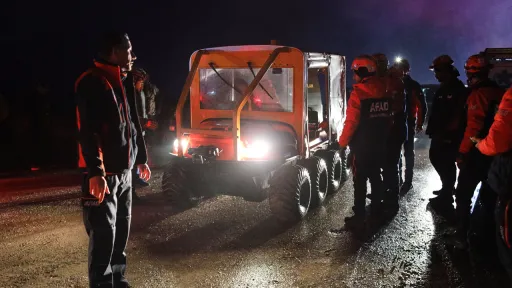By Sylvia Chebet
As the world's renowned landmark buildings in megacities switched off lights for an hour to mark the Earth Hour on March 23, women in Amboseli surrounded by a wilderness set out to mark the hour by doing something unique for the earth.
They dug hundreds of half-moons which also resemble the smiley emojis inside the expansive Amboseli Conservancy on the foothills of the snowy Mt. Kilimanjaro.
The semi-circular soil walls serve a crucial purpose, collecting runoff rainwater that would otherwise wash away over dry, barren ground, causing erosion and flash floods.
"Actually, quite some transformation is already happening. We've seen a green up springing of grass and it's actually really inspiring the people that are doing the work, they are seeing the results almost immediately," restoration manager of the Big Life Foundation overseeing the project Ernest Lenkoina tells TRT Afrika.
Ngameri Maiyo, a community member in the conservancy, couldn't agree more.
"Our cows have got grass, and a variety of wild animals are now stationed here; zebras, gazelles, even lions these days come to wait for gazelles there because it has become green. We have done very well,” she says.
“The wild animals used to give us a lot of trouble on the farm. Even these antelopes, if you plant beans, they eat them, you have to plant another crop altogether. This project has made me happy,”Ngameri adds.
The conservancy is a critical wildlife dispersal area and corridor between Amboseli and Tsavo National Parks. It is also very important for livelihoods for the Maasai community, and they largely use it for livestock grazing.
Earth Smiles
Typically measuring 2.5 metres in length and 5 metres in width, the earth smile is about the size of a small elephant.
Positioned on slopes with the 'closed' side facing downhill, these bunds efficiently capture and slow down water runoff.
As a result, not only do they collect rainwater, but they also allow for absorption into the soil and retention between the bunds.
These semi-circular soil structures, designed to conserve water and prevent soil erosion, have proven effective in enhancing soil fertility, restoring degraded lands, and mitigating the impacts of climate change.
"And because the bunds are done in a large scale, then increasingly they spread until the whole landscape is covered with green vegetation," Samuel Jakinda, 'Just Dig It' programme manager adds, noting that this is significantly impacting biodiversity, nature, people, and the climate.
"We are using the bunds as a climate resilience intervention because the area is highly degraded and the degradation is largely because the traditional grazing system has collapsed. Dr. John Kioko, programmes coordinator for the World Wide Fund for Nature (WWF-K) in the Amboseli Chyulu landscape says.
"And so, we need to bring back this health of the ecosystem and the way the band is helping this is that first it acts as a micro catchment, and it is holding back the soil," he adds.
The project driven by WWF-K, Just Dig It, and Big Life and Big Life Foundation, started back in 2021 in a bid to enhance climate change resilience among communities in rangelands.
"So far, we've restored 10,000 hectares through different intervention measures and what we are realising is that since 2021 there are evidence results and these include improved cover within some of these sites," WWF-K's Kioko says.
The community has witnessed an increase in biodiversity in their own land including new insect, bird and animal species alongside new vegetation. This has inspired the women to keep on digging the bunds.
"For us we have been doing Earth Hour every day. Every morning, we come here and work on Earth Hour. Earth Hour should be ongoing. Personally, I dig six trenches from 7:30am to 2pm . If all 120 of us women dig six bunds each in a day, that's a lot of bunds," Valentine Semeya says
"Let's collaborate, let's join forces and let's accelerate restoration of degraded areas." Jakinda adds.
Women at Work
"The leaders of the programme are actually women. And it was by design because we realised that climate change impacts women more although they really don't come to the streets and do all that complaining."
Sketa Imelaisa, a community member of the conservancy believes the project will have significant positive impact.
"Sometimes the drought overwhelms us. We have livestock and there is nowhere for them to graze, but in the coming years, we see that this grass will help us as Maasai people," Imelaisa says.
"During the dry seasons, we used to buy grass. If you didn't have money, you might even feel tempted to steal because you need grass for your cows but can't afford it,"Purity Seya adds.
"When cows come here, they'll be satisfied, and we'll get milk to support our children's lives. We'll also earn money to support our groups, and our children will be able to go to school."
➤ Click here to follow our WhatsApp channel for more stories.
























